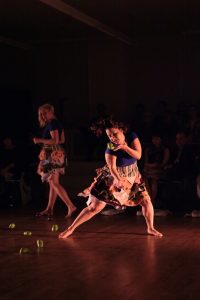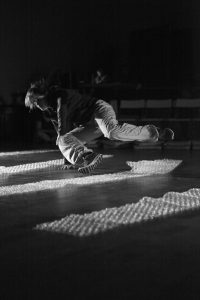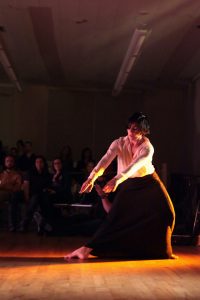Dance and the Right to Privacy at YouTurn
Created in 2011 by the savvy young dance artists Erica Buechner, Anne Gehman, and Maria Juan, YouTurn puts on an annual show that mixes dance/performance, visual art, and eats and drinks in a party atmosphere. The latest edition was last weekend at the White Box Theater, and, whether intentionally or not, the program offered an intriguing progression from a highly performative piece geared to an audience, to one combining a personal focus with performance, to a piece that felt so intensely private it was like peeking through curtains into the dancer’s living room.
Gehman and Juan choreographed and performed the audience-oriented opener, “The Figs of Plath,” which used some two dozen “figs” – actually, green- and purple-shellacked potatoes made by set designer Sarah Larson. Gehman and Juan at times grabbed as many figs as they could hold and jealously guarded them. More often, they left figs scattered on the floor as they connected in mirrored gestures, or grappled, or provided mutual support. There was a delicious sense of danger when they dashed and pivoted among the strewn figs. You couldn’t take your eyes off their feet; a misstep, and someone could go flying. And Gehman’s feet in particular are striking – spongy and agile-toed, capable of going into a high-arched demi-pointe.
Really, everything about Gehman is riveting: her expressiveness and strength, the sense when she made eye contact with Juan that she was also taking the audience into her gaze and inviting/daring us to look back. Her performance was what most stuck with me, versus the piece as a whole. “The Figs of Plath” was inspired by Sylvia Plath in “The Bell Jar” writing about facing an overwhelming profusion of possibilities, like a tree filled with figs, and being unable to choose among them. Certainly, the dancers’ ambivalence about whether to load up on figs or drop them illustrated that conflict, but it was facile. And comic elements – the tongue-in-cheek title, the potat0-figs, tattersall-skirted costumes that suggested Pierrettes – might, if the piece had gone with some depth into Plath’s darkness, have been a source of interesting friction; as it was, the humor contributed to a confusion in tone.
In an impeccably focused solo, Erica Buechner navigated a grid in which strips of floor alternated with lengths of bubble wrap. She began by moving deliberately, initiating each movement by pushing on a body part with her hand and verbally labeling what she was doing: “Internal tibial rotation.” “Cervical spine spiraling right.” Carefully placing her feet, she stepped across the lines of bubble wrap to stay on the floor. But then her movement got wilder, and yippee! there was that exciting pop the first time she landed on the bubble wrap. Like an express elevator, she transitioned from floor to standing and back to the floor. Whipping around, she ended up with almost all the bubble wrap tangled around her legs, the neat linear pattern transformed into a twisted mess, and isn’t that like life?
Buechner had a strong internal focus, and I suspect her title, “Between my fist and my Pollyanna,” is a private joke, but the clarity of her onstage presence made for an engaging performance.
There was also the sense of glimpsing a private world in Katie Griffin’s “the third-best-time is now,” starting with Griffin singing a plaintive a cappella song in the dark, followed by a dimly lit section in which we only saw Virginia Broyles’ legs through a filmy skirt. It was an enchanting image, Broyles’ feet twisting as she moved within in a tight square, and the obscurity mysterious and tantalizing.
But when the lights came up, the sense of obscurity continued, and it felt like a barrier. Even as Morgan True flung herself across the space, and the three women did agitated unison movements on the floor, their gazes seemed internal, and I had the sense of watching a private experience. That was even more the case when Griffin did a lyrical solo, a hand fluttering at her heart, arms and legs sweeping through the air. From the photo, you can see what gorgeous lines she created. Yet, with eyes downcast and hair partly covering her face, she seemed to disinvite engagement. Putting the audience at a remove may be precisely what Griffin intended, but it left me feeling uninvolved.
Also at the YouTurn party were the fantastic gypsy blues duo Yael and Vlady and artists Hill Young and Scarlet Astrid, whose installation-performance made me feel that, while bubble wrap never gets old, body painting does.

Award-winning dance journalist Janice Steinberg has published more than 400 articles in the San Diego Union-Tribune, Dance Magazine, the Los Angeles Times, and elsewhere. She was a 2004 New York Times-National Endowment for the Arts fellow at the Institute for Dance Criticism and has taught dance criticism at San Diego State University. She is also a novelist, author of The Tin Horse (Random House, 2013). For why she’s passionate about dance, see this article on her web site, The Tin Horse



